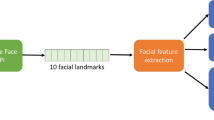Abstract
Purpose
This article describes the assembly of a cost-efficient system to enable contact-free volumetric measurement of facial volumes.
Methods
The system was built from low-cost standard equipment, including Lego bricks, standard CCD camera, laser module, USB board, and stepper motor. The total cost was less than 200 €. At different time intervals, depth data were captured with a sweeping laser line to subsequently determine volumetric models of the object under investigation.
Results
The obtained volumetric data were imported in the open-source software ParaView (Kitware Inc., New York, NY, USA) as standard comma-separated files. The absolute errors of the obtained depth values increased from 0.5 to 3.52 mm between 30 and 90 cm of defined object distance, respectively. The relative errors increased from 0.3 to 0.76 %, respectively.
Conclusions
This study proves that applicable volume scanners can be built using low-cost components.




Similar content being viewed by others
References
Weinberg SM, Scott NM, Neiswanger K, Brandon CA, Marazita ML. Digital three-dimensional photogrammetry: evaluation of anthropometric precision and accuracy using a Genex 3D camera system. Cleft Palate Craniofac J. 2004;41:507–18.
Ji Y, Zhang F, Schwartz J, Stile F, Lineaweaver WC. Assessment of facial tissue expansion with three-dimensional digitizer scanning. J Craniofac Surg. 2002;13:687–92.
Ma L, Xu T, Lin J. Validation of a three-dimensional facial scanning system based on structured light techniques. Comput Methods Programs Biomed. 2009;94:290–8.
Schwenzer-Zimmerer K, Chaitidis D, Berg-Boerner I, Krol Z, Kovacs L, Schwenzer NF, et al. Quantitative 3D soft tissue analysis of symmetry prior to and after unilateral cleft lip repair compared with non-cleft persons (performed in Cambodia). J Craniomaxillofac Surg. 2008;36:431–8.
Bretschneider T, Koop U, Schreiner V, Wenck H, Jaspers S. Validation of the body scanner as a measuring tool for a rapid quantification of body shape. Skin Res Technol. 2009;15(3):364–9.
Chaudhuri S, Rajagopalan AN. Depth from defocus: a real aperture imaging approach. New York: Springer-Verlag; 1999.
Creath K, Wyant JC. Moiré and fringe projection techniques. In: Malacara D, editor. Optical shop testing. Hoboken: John Wiley and Sons; 1992. p. 653–83.
Schwenzer-Zimmerer K, Boerner BI, Schwenzer NF, Mueller AA, Juergens P, Ringenbach A, et al. Facial acquisition by dynamic optical tracked laser imaging: a new approach. J Plast Reconstr Aesthet Surg. 2009;62:1181–6.
van der Zel JM. Implant planning and placement using optical scanning and cone beam CT technology. J Prosthodont. 2008;17:476–81.
Bernardini F, Rushmeier H. The 3D model acquisition pipeline. Comp Graph Forum. 2002;21:149–72.
Foley JD. Computer graphics: principles and practice. Zweite ed. Boston: Addison-Wesley. Addison-Wesley systems programming series; 2008.
Selvarasu N, Nachiappan A, Nandhitha N. Abnormality detection from medical thermographs in human using Euclidean distance based color image segmentation. In: International Conference on Signal Acquisition and Processing, 2010 February 9–10; Bangalore, India, IEEE Computer Society Washington; 2010. pp. 73–75.
Zhang YY, Wang PSP. A parallel thinning algorithm with two-subiteration that generates one-pixel-wide skeletons. In: Proceedings of the 13th International Conference on Pattern Recognition, Volume IV; 1996 August 25–29; Vienna, Austria. IEEE Computer Society Washington; 1996. pp. 457–461.
Gorton GE 3rd, Young ML, Masso PD. Accuracy, reliability, and validity of a 3-dimensional scanner for assessing torso shape in idiopathic scoliosis. Spine. 2012;. doi:10.1097/BRS.0b013e31823a012e.
Brüllmann D, Jürchott LM, John C, Trempler C, Schwanecke U, Schulze RK. A contact-free volumetric measurement of facial volume after third molar osteotomy: proof of concept. Oral Surg Oral Med Oral Pathol Oral Radiol. 2014;. doi:10.1016/j.oooo.2012.03.036.
Metzler P, Bruegger LS, Kruse Gujer AL, Matthews F, Zemann W, Graetz KW, et al. Craniofacial landmarks in young children: how reliable are measurements based on 3-dimensional imaging? J Craniofac Surg. 2012;23:1790–5.
Acknowledgments
The scanner was developed by Tobias Muench during his studies for a doctorate according to an idea of Dan Brüllmann and Ralf Schulze. All three authors agree that they contributed equally to this study.
Author information
Authors and Affiliations
Corresponding author
Ethics declarations
Conflict of interest
Dan Brüllmann, Tobias Muench, and Ralf Schulze declare that they have no conflict of interest.
Human rights statements and informed consent
All procedures followed were in accordance with the ethical standards of the responsible committee on human experimentation (institutional and national) and with the Helsinki Declaration of 1964 and later versions. Informed consent was obtained from all patients for being included in the study.
Rights and permissions
About this article
Cite this article
Brüllmann, D., Muench, T. & Schulze, R. Construction of a low-cost surface scanner for medical studies: a feasibility study. Oral Radiol 32, 211–216 (2016). https://doi.org/10.1007/s11282-016-0236-x
Received:
Accepted:
Published:
Issue Date:
DOI: https://doi.org/10.1007/s11282-016-0236-x




